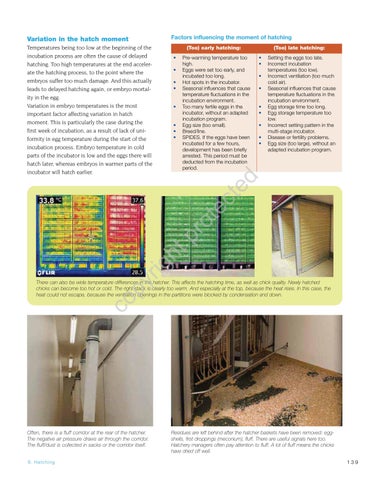Factors influencing the moment of hatching
Variation in the hatch moment Temperatures being too low at the beginning of the incubation process are often the cause of delayed hatching. Too high temperatures at the end accelerate the hatching process, to the point where the embryos suffer too much damage. And this actually leads to delayed hatching again, or embryo mortality in the egg. Variation in embryo temperatures is the most important factor affecting variation in hatch moment. This is particularly the case during the first week of incubation, as a result of lack of uniformity in egg temperature during the start of the incubation process. Embryo temperature in cold parts of the incubator is low and the eggs there will hatch later, whereas embryos in warmer parts of the incubator will hatch earlier.
(Too) early hatching: • • • •
•
• • • •
• • • • •
Setting the eggs too late. Incorrect incubation temperatures (too low). Incorrect ventilation (too much cold air). Seasonal influences that cause temperature fluctuations in the incubation environment. Egg storage time too long. Egg storage temperature too low. Incorrect setting pattern in the multi-stage incubator. Disease or fertility problems. Egg size (too large), without an adapted incubation program.
py
rig
ht
pr ot
ec
te
d
• • •
Pre-warming temperature too high. Eggs were set too early, and incubated too long. Hot spots in the incubator. Seasonal influences that cause temperature fluctuations in the incubation environment. Too many fertile eggs in the incubator, without an adapted incubation program. Egg size (too small). Breed/line. SPIDES. If the eggs have been incubated for a few hours, development has been briefly arrested. This period must be deducted from the incubation period.
(Too) late hatching:
co
There can also be wide temperature differences in the hatcher. This affects the hatching time, as well as chick quality. Newly hatched chicks can become too hot or cold. The right stack is clearly too warm. And especially at the top, because the heat rises. In this case, the heat could not escape, because the ventilation openings in the partitions were blocked by condensation and down.
Often, there is a fluff corridor at the rear of the hatcher. The negative air pressure draws air through the corridor. The fluff/dust is collected in sacks or the corridor itself.
9. H at c h i n g
Residues are left behind after the hatcher baskets have been removed: eggshells, first droppings (meconium), fluff. There are useful signals here too. Hatchery managers often pay attention to fluff. A lot of fluff means the chicks have dried off well. 139








































































































